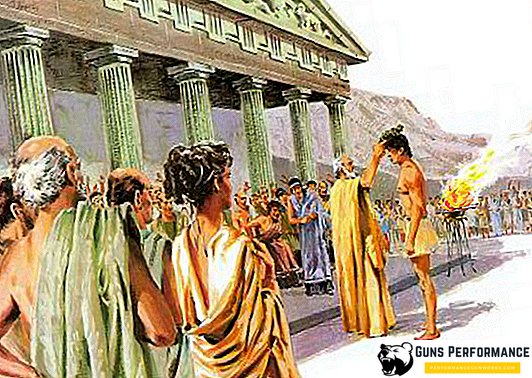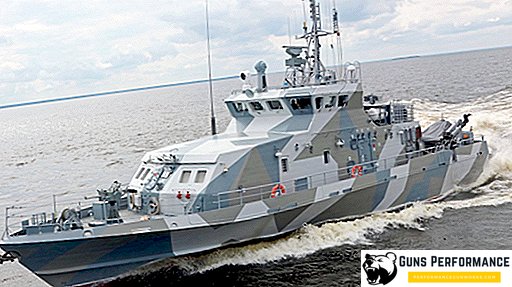Not everyone knows that Cyprus is not part of Greece, it is a separate country. In the state, the republican system, at the head of the country - the president. Currently, the presidency of Cyprus is Nikos Anastasiadis, re-elected for a second 5-year consecutive term in 2018. According to the constitution, the head of the republic can be selected an unlimited number of times.
The history of Cyprus before the seizure of ancient Rome

The first information about the presence of settlements on the island of Cyprus, scientists refer to the seventh millennium BC. The inhabitants of these territories preferred to settle near rivers and hills, their main occupations were:
- gathering;
- hunting;
- fishing;
- cattle breeding;
- primitive farming.
At the end of the Stone Age, the inhabitants of the island learned how to mine copper and make weapons and various products out of it. This marked the beginning of the copper age.
The local population was actively involved in trading in copper products, which in 1400 BC attracted the ancient Mykene who started to establish their colonies in Cyprus. This contributed to the development of traditional Greek culture in the region, the language and religion of the ancient Greeks. According to the Greek legends, the heroes of the Trojan War began to settle in Cyprus with their retinues and their families. The Greeks did not represent life outside the policy, their main task was the establishment of city-states. Cities were strengthened by powerful walls, and monuments were built inside, which are works of art.
The local population aspired to the cities, powerful walls could protect them from enemy raids, so soon 10 city-states appeared in Cyprus. This marked the beginning of the Greek period and the prosperity of the island until 750 BC. The inhabitants of Cyprus became famous masters of ancient Greece, they achieved perfection in the following arts:
- making weapons and metal armor;
- architecture;
- weaving;
- processing ivory and marble.
City-states began to grow rich quickly, the locals were also great navigators, which attracted the attention of militant neighbors.
From 750 to 475 BC, Cyprus waged constant wars with conquerors. City-states tried to preserve their independence, not realizing that the time of empires had come. Gradually, all independent states fell under the rule of the Assyrians, Egyptians and Persians. The latter managed to subdue the whole of Cyprus. Since 475, the ancient Greeks have repeatedly tried to regain the island. The rulers of Athens tried their best, they, along with the troops of the Cypriot states, constantly attacked the Persians. Military art did not help the ancient Greeks in the fight against Persian troops. According to the peace treaty concluded between the Persians and the Greeks, the Cypriot city-states were forced to pay tribute to the conquerors.
In 332 BC, Alexander the Great defeated the Persian army and liberated Cyprus from the long-term tyranny of foreign invaders. The island state has entered a new phase of its development. After the collapse of the empire of Alexander of Macedon, Cyprus went to the Egyptian Ptolemaic dynasty of Greek origin, the founder of the family was the commander of the famous conqueror.
The Ptolemies abolished the city-states and created a single kingdom, the capital was in Paphos. It was a long peace period, which brought Cyprus:
- the development of traditional Greek culture;
- economic recovery after constant wars and the Persians;
- the spread of the traditional ancient Greek alphabet.
Such prosperity ended in 31 BC, Cyprus fell under the authority of the Roman Empire.
Cyprus as part of the Roman Empire and Byzantium

In 31 BC, the island fell under the authority of the Roman Empire. This happened after losing the battle during the action of the joint troops of Anthony and Cleopatra. In 45 AD, Cyprus adopted the Christian religion. The main merit in this event belongs to the apostles Paul and Barnabas. Cyprus became the first province of the Roman Empire, ruled by the vicarious Christian Ambrose of Milan. In 313, all Christians of the Roman Empire received the right to free religion, thanks to the works and decrees of Ambrose.
In 325, the Bishops of Cyprus took an active part in the First Ecumenical Synod, held in Nicea. This period has become favorable for the development of the economy and culture of the island:
- trade developed at a high rate;
- New theaters, temples, and other architectural structures were built.
This went on until 647, when the first Arab raid on Cyprus took place. For a period of almost 300 years, the island became a desirable booty for Arabs and pirates who committed their predatory and predatory campaigns.
In 965, Cyprus received military assistance from the Emperor Phocas, after which it was incorporated into the Byzantine Empire. Fock liberated the island for a reason; he needed a kind of barrier from the Arab Caliphate and other Muslim states. New castles and monasteries began to be built on the island, if necessary, also serving as fortresses and shelters:
- The castle of Saint Hilarion;
- Vufvento Castle;
- Castle Cadaras;
- Monastery of Macheras;
- Monastery of Saint Neophytos;
- Monastery of the Virgin Kykkos;
- Monastery of St. John Chrysostom.
It is a huge number of monasteries that indicates that the Byzantine Empire was at that time at the peak of its power.
In 1191, the English king Richard the Lionheart participated in the third crusade. Not far from the city of Limassol, located in the southern lands of Cyprus, the ship with the sister of the king was shipwrecked. The ruler of the island of Cyprus refused to help a member of the British royal family, while showing the traditional for that time Byzantine vanity. The enraged king of England seized Cyprus and soon sold it to the Templar forces for 100,000 dinars.
Cyprus under the rule of France, Turkey and England

Naity, who bought Cyprus from Richard the Lionheart, began to rob the local people, which caused a serious uprising. Not wanting to spend forces on the suppression of the conflict, the Templar Naita sold for the same 100,000 Cyprus dinars to the king of the Franks, Gu de Luzinian, the era of French rule began. The new government began to carry out reforms aimed at maximizing profit:
- The local people were turned into slaves, as their lord Guy de Luzinian introduced the feudal system on the island;
- Greek faith was replaced by the Catholic;
- All adherents of the orthodox Greek faith were persecuted by the Catholics.
The capital of the state was Nicosia, where the residence of the French king. In 1489, Queen Catherine Kornar gave Cyprus Cyprus.
For about 100 years, the island was part of Venice, but the Turks were constantly trying to capture it. Despite the construction of new fortifications and the desperate resistance of the inhabitants of Cyprus, the Ottoman Empire seized Nicosia in 1570, killing about 20,000 defenders of the capital. The next goal of the Turks was the city of Famagusta, which they had to besiege for about a year. After its fall, the whole of Cyprus fell under the rule of the Ottoman Empire, which decided to rule the island on the principle of dragomania:
- the dragoman has been collecting taxes;
- made all the calculations;
- rewrote all the property of the inhabitants of Cyprus for the calculation of taxes.
The most famous dragoman was Hadjigeorgakis Cornesius. It is believed that he tried his best to make life easier for Cypriots, but at the same time remained the richest man on the island. Fraud and corruption led the official to the fact that he was summoned to Constantinople and executed there on the orders of the Ottoman ruler. According to another theory, Kornesii fell victim to a political conspiracy, as many Ottoman officials wanted to take his place.
In 1821, a revolution began in Cyprus, whose main goal was liberation from the Turkish yoke. The troops of the Ottoman Empire severely dealt with the rebels, killing more than 100,000 civilians. Taking advantage of the moment, the Turks turned most of the Orthodox churches into Muslim mosques. In 1878, Great Britain and the Ottoman Empire concluded an agreement between themselves, and Cyprus came under the influence of the English crown. At the same time, the island was officially part of the Ottoman Empire until the beginning of the First World War.
When Turkey entered the war on the side of Germany, Cyprus formally became an English colony. Delighted residents were confident that the UK would immediately transfer Cyprus under the rule of Greece. In 1923, Turkey officially renounced Cyprus, and in 1925 the island became officially called the colony of England, which led to changes in the country:
- Officially allowed the Orthodox faith;
- Many mosques were destroyed by the local population;
- During World War II, Cypriots voluntarily fought for Britain, confident that the British government would appreciate this contribution and give the island the right to autonomy.
Cyprus remained a colony. Realizing that nothing could be achieved by peaceful means, the local people organized a national liberation movement. In 1955, a period of armed clashes with the administration began, to which the British responded with arrests and executions. Only in 1960, Cyprus managed to gain independence.
Independent Cyprus and the problems of the new state

Since the region has long been ruled by the Ottoman Empire, this affected its national composition. In 1960, a constitution was adopted, according to which the island was divided into Turkish and Greek communities. At the same time, the Greek part of the population was about 80%. The Greeks and Turks have traditionally disliked each other, so since 1960 there have been constant clashes between them. This resulted in an armed conflict in 1974, with supporters of Greece, most of whom came to power.
Offended Turks turned for help to their state, and soon the Turkish army landed in Cyprus:
- The Turks captured about 35% of the island’s territory;
- The country is officially divided into two parts;
- NATO did not support Greece in the conflict, and she withdrew from the bloc in protest;
- About 200,000 Greeks, who remained on the Turkish side, moved to the Greek part of the island.
Negotiations began, the main goal - the unification of Cyprus. The Greek community has traditionally opposed unification, and the Turkish part is for it.
For 30 years of national conflict, two regions of the country have developed in different ways. Now the economy and politics of both parts of the island are completely different from each other. In 2007, the parties came to an agreement between themselves, the wall was divided, dividing the capital into two parts. Now you can move freely from one part of the island to another. In 2008, Cyprus joined the Eurozone.
The international status of states in Cyprus

The status of the Republic of Cyprus as a sovereign state is now recognized by all countries of the world, except Turkey. At the same time, the Turkish Republic of Northern Cyprus (TRNC) does not recognize its neighbor, calling it "the Greek authorities of Southern Cyprus." In turn, the Republic of Cyprus does not recognize the TRNC, stating that these are territories illegally occupied by the Turkish authorities. Since May 1, 2004, Cyprus is a member of the European Union, but it is not part of the Schengen zone. Legal laws in force in the European Union do not apply in the territory of the TRNC.
Today is the legal way to get to the island through air and sea harbors:
- Paphos airport;
- Larnaca Airport;
- Larnaca Sea Port;
- port of Limassol.
Entry into the territory of the state through the ports of Northern Cyprus or Turkey is considered illegal.
In early 2008, the Republic of Cyprus entered the European zone, and the euro began to play the role of the national currency. The Cyprus Pound has been canceled. When President Nikos Anastasiadis was elected, the population of the republic planned that the country would join NATO, but Turkey constantly obstructs this, since it does not recognize the Republic of Cyprus.
About 38% of the island is under the authority of the Turkish Republic of Northern Cyprus, but the Greek authorities still claim that 98% of the territories belong to them (with the exception of British military bases).
Diplomatic relations with Russia were established in 1960 under the Soviet Union. In 1992, Cyprus recognized Russia as the successor of the USSR. The embassy is located in Moscow, and the republic's consulate in St. Petersburg.
List of presidents of Cyprus and some significant events in their years of government

After gaining independence of the Republic of Cyprus in 1960, the president was immediately elected, and the first elections were held in 1959. List of Heads of State:
- 1960-1974 - Archbishop Macarius III. He tried to contain national conflicts in the republic, but was overthrown in 1974 with the support of the Greek junta, which was agreed with Turkey (in fact, betrayed Cyprus);
- 1974 - Nikos Sampson. He came to power in a coup. In the same year he was forced to resign;
- 1974 Glavkos Clerides played the role of the head of state;
- 1974-1977 - Archbishop Macarius III. He returned to power, and served as president until his death in 1977;
- 1977-1988 - Spyros Cyprianou. After his inauguration, he became in fact the second president of Cyprus, although formally he is the fifth leader of the republic;
- 1988-1993 - Georgios Vasiliou. He stood with the support of the Communists, in 1993 he was the official candidate of the Communist Party, but lost;
- 1993-2003 - Glafkos Clerides. He was elected for two consecutive terms, but could not cope with the economic crisis of the early 2000s;
- 2003–2008 - Thassos Papadopoulos. He opposed the plans of UN Secretary-General Kofi Annan to resolve the Cyprus conflict;
- 2008-2013 - Dimitris Christofias. He promised that he would achieve the reunification of Cyprus, did not fulfill his main promise.
Currently, the President of the Republic of Cyprus is Nikos Anastasiadis, who in 2018 was re-elected for a second term.
Responsibilities of the President of Cyprus and his residence

The status of the head of the island state is quite high:
- The president is the chief executive;
- Appoints ministers and their deputies;
- Forms with the help of the Prime Minister the government;
- May dissolve the parliament of the republic;
- He is the Supreme Commander of the Armed Forces;
- Grants the highest military ranks, awards state awards and so on.
Presidential orders are not legislative in nature, but the government is obliged to listen to them.
The modern residence of the head of state has an interesting history. Initially, the presidential palace was built for the governor of Great Britain, Sir Garnet Joseph Wolzley. Unlike other English residences, it was a wooden house built around 1878. It was built outside of Cyprus, and only met on the island. In this form, the residence existed until 1931, it was burned as a result of an armed uprising.
Therefore, the British decided to build a stone palace, using the traditional Greek style. After gaining independence by Cyprus in 1960, the residence of the first president was staged at the former residence of the British governor. In 1974, when the junta came to power, the palace burned down again. But in 1979 it was restored, thanks to sponsorship from Greece. Now here is the reception of the President of the Republic of Cyprus.
Currently, the government of the republic continues to negotiate with the Turkish Republic of Northern Cyprus, in the hope of uniting the island into a single state. If this happens, Muslims and Orthodox will live together in peace and harmony.












